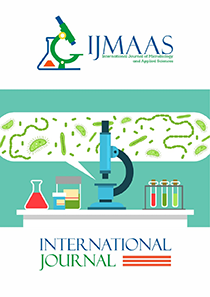Microbial Hazards Associated With Floodwater
Vol 3, Issue 1, 2024
KEYWORDS
Floodwater, E. coli, Shigella, Microsporum canis, drinking water, health risk.
Abstract
Flood is a natural event where an area that is usually dry land suddenly gets submerged by water. Floodwater is generally contaminated by various contaminants including human and animal feces, chemicals and sewage. Humans and other animals are at risks of exposure to microorganisms in floodwater which are threat to health. An investigation was conducted to assess microbial hazards associated with floodwater. A total of 21 floodwater samples was collected from three locations in Aba, Abia State and analyzed for total heterotrophic bacteria, fecal coliforms, fungi and some physicochemical properties using standard techniques. Bacterial counts for the locations ranged from 3.3 × 106 to 5.2 × 106 cfu/ml; Thermotolerant and faecal coliform bacteria ranged from 26 to 920 MPN index/100ml; while fungal counts ranged from 2.0 × 103 sfu/ml to 5.0 × 103 sfu/ml. The BOD was 9mg/L – 20mg/L and electric conductivity was 400µs/cm – 12,000µs/cm. Bacteria isolated and frequency were; The bacteria isolated and their frequency of occurrence in the floodwater during the study were, Alcaligenes bronchisepticus (2.4%), Bacillus (4.8%), Campylobacter fetus (4.8%), Enterobacter aerogenes (4.8%), Escherichia coli (21.4%), Klebsiella (7.1%), Listeria monocytogenes (2.4%), Micrococcus luteus (4.8%), Proteus sp (2.4%), Serratia sp (4.8%), Shigella sp (11.9%), Staphylococcus (7.1%), Streptococcus pneumoniae (11.9%), Vibrio cholerae (7.1%), and Yersinia sp (7.1%). While the fungi isolated and frequency of occurrence were Aspergillus niger (14.82%), Aspergillus oryzae 7.41%, Epidermophyton flocossum 11.11%, Fusarium solani (11.11%), Microsporium canis (3.7%), Mucor sp (18.51%), Penicillium sp (14.82%), Rhizopus sp (7.41%), Rhizopus oligospora (3.7%), and Saccharomyces cerevisae (7.41%). The presence of these microorganisms especially E. coli is an indication that the floodwater is faecally contaminated and poses a health risk to the public.
Current: Vol. 3, Issue 2, 2024

Call for papers
The International Journal of Microbiology and Applied Sciences warmly welcome your valuable articles for publication.
